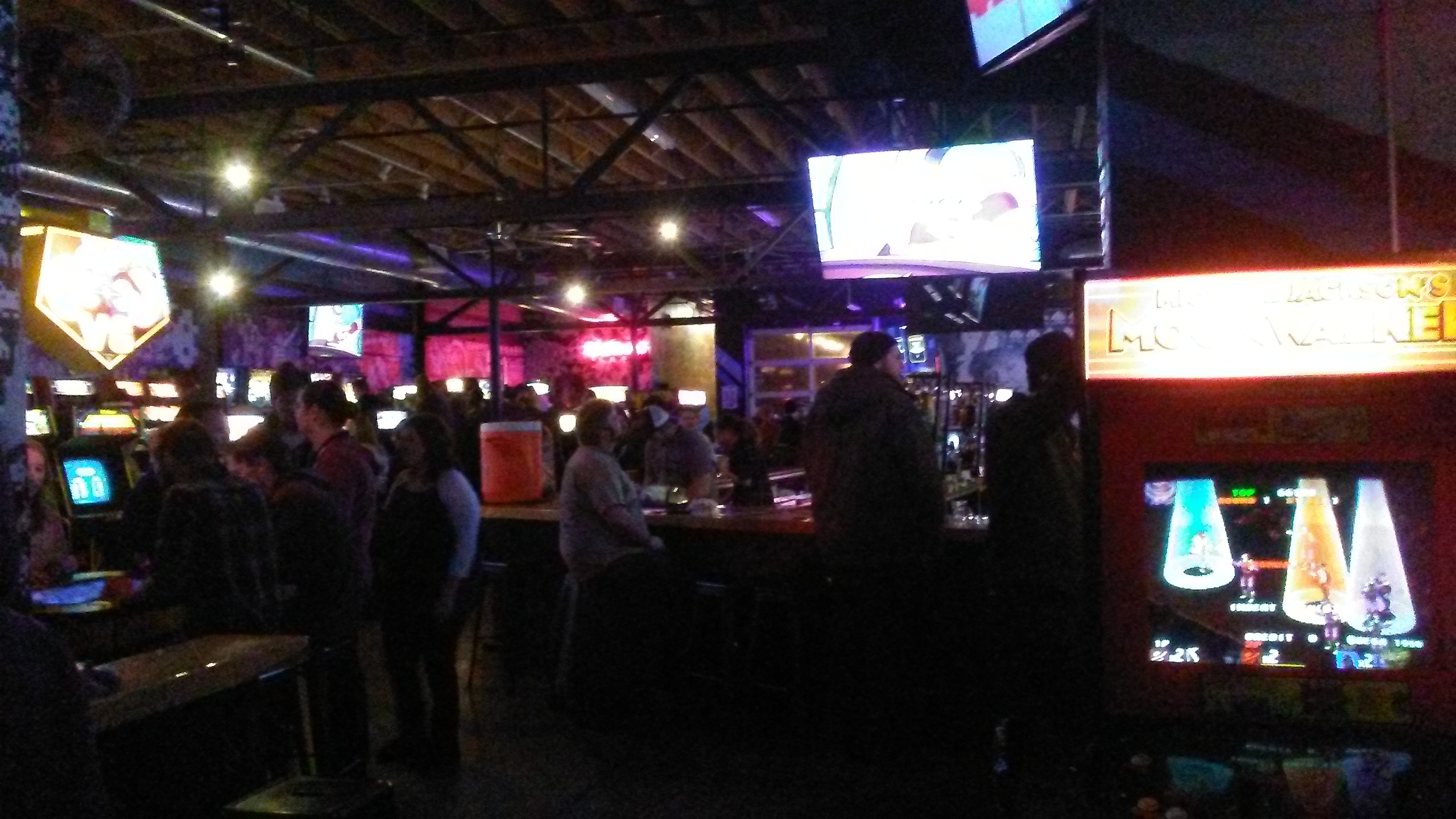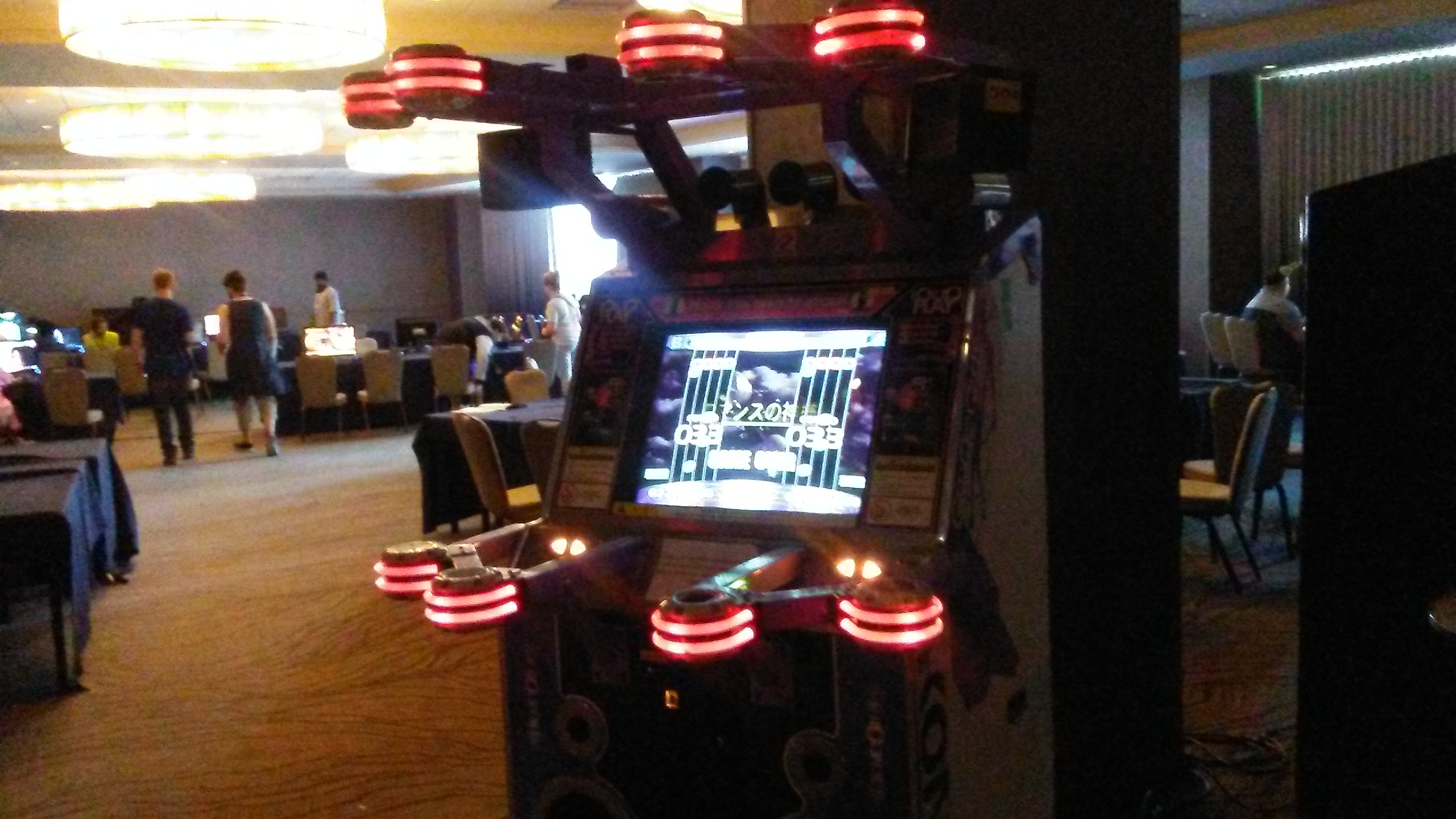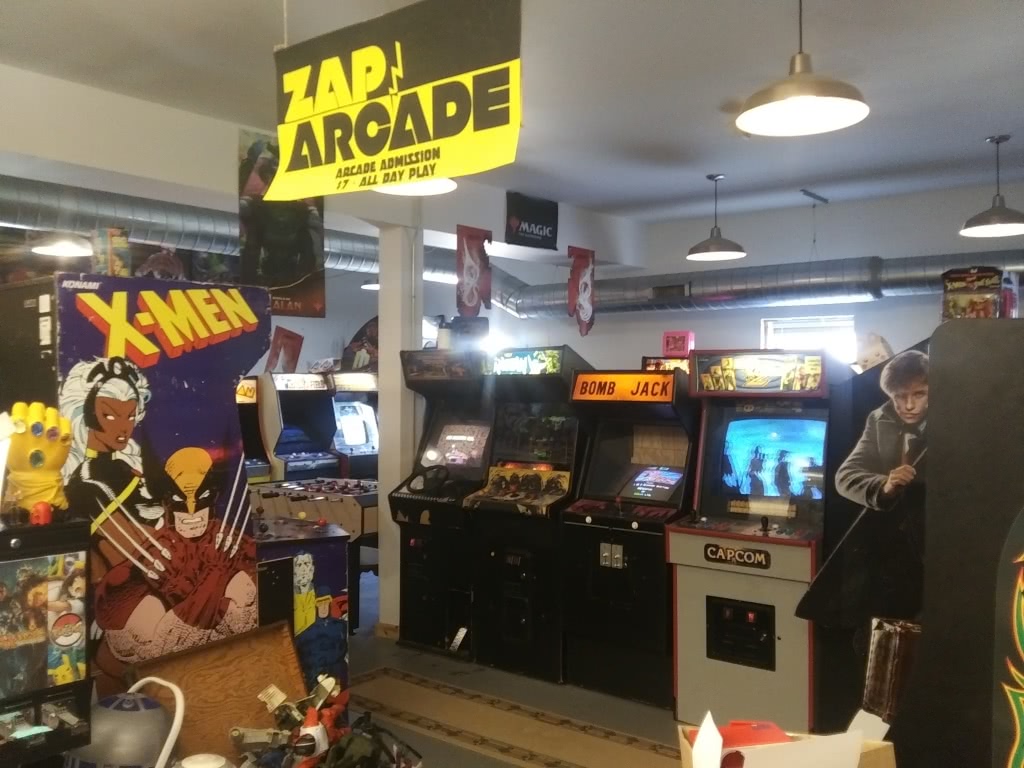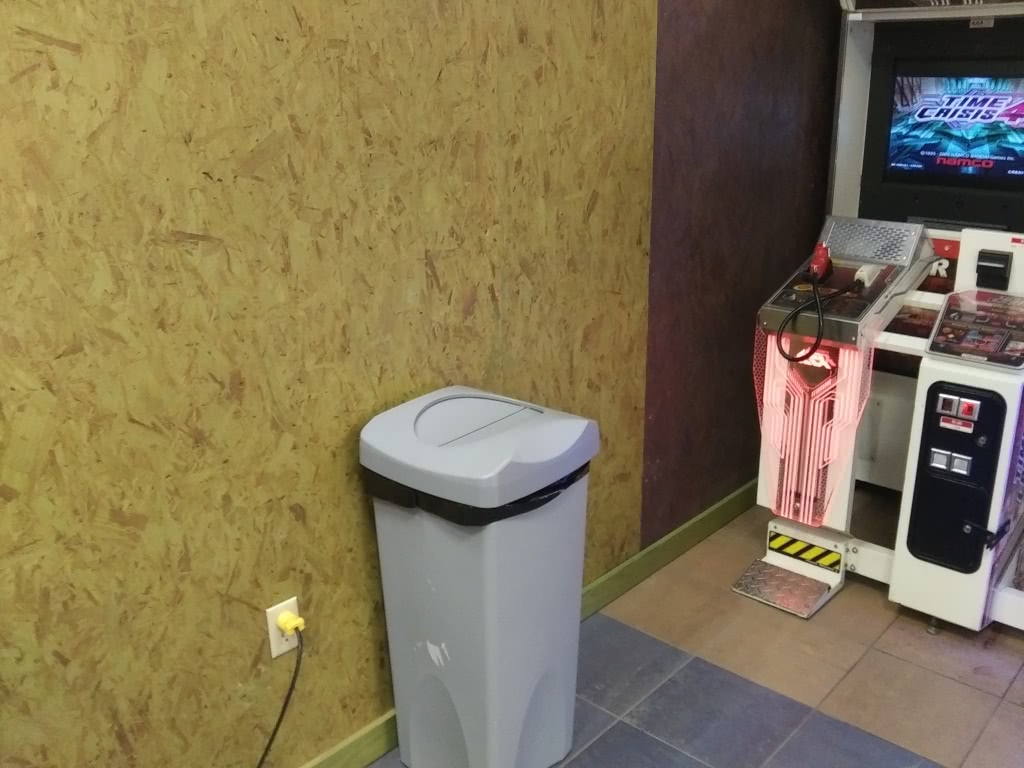DISCLAIMER: This was one of my earliest blog posts. Forgive the fact that I had no idea what I was doing.

Welcome to Uptown Minneapolis!
…take a good look because that’s the only shot of it you’ll see in this blog post. While I’m sure it’s filled with exciting stuff to show the four-ish people reading this, I’m going to share an exciting fact instead: Minneapolis is the coldest major city in the country. A few weeks ago, it went down to -27 degrees at night. It ended below zero when I got here, and I didn’t bother wearing gloves. On my way back, I walked in the wrong direction to the bus transfer and roamed around, lost in this weather for half an hour.
It’s important that everyone reading this knows that bit of context because it’s also my excuse for forgetting to take a picture of the building.

Over the last several years, a new breed of gimmicky bar/arcade hybrid known as “barcades” have been popping up in the downtown area of every major city. I’ve mentioned that I’m generally not a fan of these places. Their arcade selection is usually half-hearted, consisting mainly of Donkey Kong, Pac-man, and every other typical 80s arcade game that everyone’s played a million times. However, Up-Down’s website mentioned having a rather unusual cab that I’ve always hoped to run into. Spoiler warning: They didn’t have it.

Up-Down is a chain of barcades that’s been popping up in the midwest lately. This particular location just opened up half a year ago. It’s pretty much what you’d expect, playing up the nostalgia angle hard with multiple TVs around the establishment playing Rocko’s Modern Life nonstop (although I didn’t pay enough attention to tell whether the channel was set to Nicktoons Network during a Rocko marathon or if they have the show playing on loop).
I should also apologize in advance for the phone pictures. It turns out my camera wasn’t charged. Plus, this place is dark as shit, so half of these came out looking like shit.

Look, they have their own tokens!
Tokens are sold in batches of 5 dollars. By “batches,” I mean “they hand you a plastic cup with 5 dollars worth of tokens”. Every game is a quarter anyway, so it lasts a long time.

Spending too much time on one thing makes you a loser. When you’ve spent so much time on something that you’ve transcended common sense and stared so deeply into the abyss that the only thing staring you back is yourself, you’ve reached the point where people can only stare at you in awe and wonder.
I once worked on a “game development” project with a guy who goes by the handle CrossRook. In the past year, he’s drunk 345 different types of beer and earned 245 badges on Untappd. It’s impossible not to respect someone who can turn getting drunk into an art form. Since I’m not going to a Barcade sober, I asked him for a recommendation. The result is the “B-side Pils”. It’s the most beer-tasting beer I’ve ever had. I’m sure it was probably good?

…anyway, let’s get to the games. The first thing you see when you walk in is this. It’s not Skeeball, as you’d expect. No, this is “Skee,” as indicated by the banner covering the “Ball” part of the game’s name. What makes Skee different from Skeeball, I guess, is that it’s Skeeball just for the sake of Skeeball. There are no tickets in this bar. The only thing you earn by obtaining a high score is peace of mind.
Or maybe Skee just wanted a hip and modern rebranding like “The Shack” or “The Hut”?

Micheal Jackson’s Moonwalker: Jokes aside, this is the first actual video game you see when you enter. While I’m sure, you’ve all heard of the Genesis Moonwalker game and perhaps the old computer one if you’re into that kind of thing, I bet you haven’t seen the arcade version at any point in the last 20 years. The reason is that the arcade board is programmed to self-destruct if the game is played too many times, so most arcades either throw these or convert them when it happens. If you think I’m joking, google “Suicide Battery.” There is a way to fix it with clever hacking, but most operators don’t care enough to bother. This game is on the rare side as a result. It’s the type of thing you’d only see at a dedicated retro arcade.
The game itself is good, believe it or not. It’s an isometric Beat-em-up where you can play as Micheal Jackson or his friends, Red Micheal Jackson and Black Micheal Jackson (black suit, not black skin). Combat is interesting since you can charge up your shots like Megaman or kick enemies to death at close range.

Gauntlet: You know, when their website said they had “Gauntlet,” I assumed they were using it as shorthand for Legends or Dark Legacy. It turns out that it was the 1985 version. This game was the very first four-player hack-and-slash game. It’s probably best remembered for the silly robotic voice with the mystical-sounding echo alerting you that “____ needs food badly” whenever you got low on health. What I find most interesting about this series is that both this game and the 3D games were extremely popular back in their day. It’s rare for an 80s arcade game to successfully jump into 3D and have a second wave of popularity like this.

Ice Cold Beer: I had no idea what this was, and it took forever to get a picture of it because there were always people playing it. You can probably get the gist of it just by looking. You use the two levers to raise each side of the bar and try to steer your token through the wall of holes. I later realized that it was supposed to be a glass of beer with the holes representing foam. It’s one of those arcade machines they made for people to put in the back of pubs next to Pac-man and the dart machine.

Nintendo 64: Having consoles set up to play is a common feature of barcades. While I grew up with the NES and SNES, the N64 is hands down one of the best multiplayer consoles ever made. While Smash is on right now, I saw people playing Mario Kart for a while, so I guess the games are interchangeable.
When I sat down to play, some black guy was already playing. He knew what he was doing and kicked my ass. He asked me if I was a Melee player because I play Jigglypuff. I’ll have you know I was playing Jigglypuff before it was cool. After the first round, I got used to the controls again and proceeded to beat him in every following match. He tried to talk me into entering a tournament after that, but I wasn’t paying attention. I tried to get another game with him later, but he left after clearing story mode: Godspeed, mysterious stranger. I’ll never forget crossing swords with you on my battlefield of choice.

Off-Road: This game. I’ve probably said before that the Simpsons game was everywhere in the 90s, but it doesn’t hold a candle to this. Casino arcades, truck stop arcades, hotel arcades, you name it. This game was a standard fixture in all of them. With good reason, too, because it’s fun as hell. I know this game was ported to the Super Nintendo at some point, but it’s not the same without the wheel.

Hydro Thunder: Here’s another common one. I guess it was everywhere because it blended the popular arcade racing genre, but the jet ski theme made it stand out from all of the sports car games at the time. I don’t have much to say about it, to be honest.
These two machines were kind of in a weird spot, so getting a good shot of them was hard. Here, let me google a brighter pic of the other one so you can see its gimmick:

Lucky & Wild: One steering wheel. Two guns.
These two machines were the only sit-down games in the place. The rest were upright. Honestly, I’ve never heard of this one, either. It’s a two-player game based on buddy cop films like Starsky & Hutch. Player one drives with one hand and shoots with the other, while the passenger shoots with the other gun (although there’s nothing stopping player two from dual-wielding). This one is fun as shit, but I had nobody to ride shotgun, so I just got my ass kicked. That’s the problem with many co-op games from the early 90s: Their difficulty is balanced around assuming two people are playing.


GI JOE, SMASH TV, and Sunset Riders: I’m going to come clean and admit that I didn’t play any of these. While I’m sure they’re all excellent games, and the latter two have pretty big cult followings, they’re tucked between the pinball games and the sit-down games. I said I’d come back and play them later but completely forgot they were over there. They are here, though, in case anyone reading this happens to live close enough actually to visit the place.
The pinball games were pretty much what you’d expect. I wouldn’t say I like taking pictures of pinball, anyway.

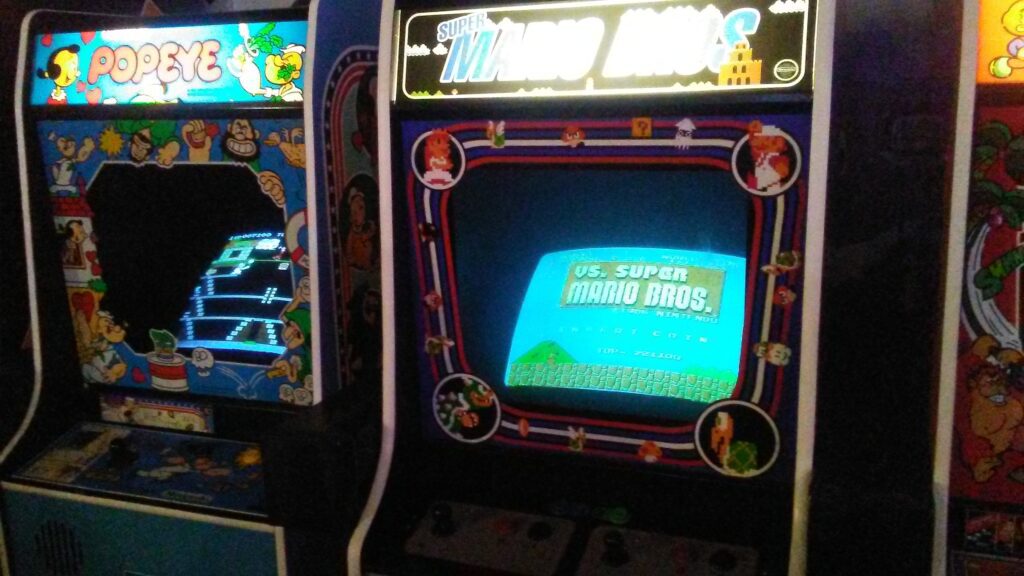
The Donkey Kong Trilogy: Somehow, I think putting these three games in a row like this was their way of showing off their complete set.
Popeye: When I was five or six, my grandparents bought a Commodore 64 from my uncle cheap and gave it to me. It had two huge boxes of (bootleg) 5-inch floppies. The Commodore port of Popeye is only of the only video games among them that anyone’s ever heard of (other than Zork and the fantastic Hitchhiker’s Guide to the Galaxy text adventure). Since the floppies were all copies, none of them were labeled. I only found that damn Popeye game once before, never being able to find it again. Playing this arcade version now was quite an experience. I spent the first 20 seconds trying to figure out which way I had to tilt the joystick to go down the first stairs, by which time Bluto was camping at the bottom, making it impossible to leave the first platform. Meh.
VS Mario Bros.: Oh, this again. I didn’t explain what this was the last time I saw it, did I? Basically, the VS System was a series of arcade hardware using similar hardware to the NES to make creating arcade ports of NES games easy. This is a practice arcades would keep doing for decades to come, but the VS System was one of the earlier examples of it. The arcade ports would often have minor changes to make them more arcade friendly, like making extra lives rarer or having a more strict timer. In Super Mario Bros’ case, nearly every level outside the first few was replaced to make the game harder. Quite a few of these new levels ended up in Super Mario Bros 2 (the one with the poison mushrooms, not Doki Doki Panic). As if we needed more evidence that SMB2 was a cheap cash grab…

Punch-Out: Look, another one of these! I’d probably be much more excited about it if there weren’t one in Vegas. The volume on it was turned up so loud that you could hear “HARD BLOW! HARD BLOW!” from the other side of the bar. Looking at it now, that top screen doesn’t contribute a whole lot to the game.

R-type, Atari Baseball: I feel these blog posts always have a lull in the middle where I burn off pictures without much to say. The machines are unusual enough to call attention to, but I have very little to say about these as some of the others. Is R-type fun?
VS. Excitebike: Another VS system game. I’m not familiar enough with the NES version to know the differences, so let’s consult Wikipedia.
The first version was released for arcades in 1984, some time after the Famicom release. The game was based around the VS. UniSystem unit. It is similar to its NES counterpart, though this version has the Design option gone and in the main game there are three difficulty levels (Beginner, Intermediate and Advanced), and there are seven tracks rather than five. The tracks mostly return from the original game with some rearrangement of track obstacles. In addition, there is no Selection A or B; each track is played the first time as a time trial, single-motorcycle qualifying heat, and the second time as an Excitebike race. Whereas the time trial has no CPU bikers as obstacles, they appear in the Excitebike race mode. As in real-life supercross heat races, riders must clear the track in fifth position or higher to advance.
tl;dr: It’s slightly different.

1943: The sequel to the far more well-known 1942. Both games in the series are pretty standard curtain shooters.
Track & Field: This game is played with only two (well, technically three) buttons: Run and Jump. There are two versions of it! In the photo, we see the trackball version, where running, in any event, requires you to spin the trackball as fast as possible. The other version swapped the trackball out for two “run” buttons that had to be tapped back and forth.

Track & Field: Oh yeah, they also had the cocktail cabinet version, which happens to use the other style of running (the darker buttons make you run in this version if you can make them out in this photo). While both versions technically support 4-players, this one has controls for all four rather than making people switch off and share the two like the upright game. Do yourself a favor and avoid the trackball version. It’s awkward to control.
The game itself is just standard Olympic minigames. You know, “run fast and push jump at the right time” and other things. The Track and Field game series continued for two decades for whatever reason.

Let’s take a break to look around the place, shall we? This is a giant Connect Four game they had two of. By “giant,” I mean it’s bigger than the home version. There’s a barcade down in… Des Moines, I think, that had a lot of oversized board games like this, including Jenga and such. This thing’s presence in some of the photos of Up-Down made me worry the place was going to be a similarly underwhelming place with a handful of emulated arcade games with giant board games to compensate for how mediocre the arcade was. I’m glad I was wrong.

Look at the fancy-ass bathrooms. It has a sink and mirrors BETWEEN the men’s and women’s rooms. This was the only well-lit section of the entire building, so I might as well take this chance to comment on the choice of decoration. Throughout the building are large monochrome murals of cities being swarmed by the Space Invaders (presumably to make friends and help us save the environment, like usual), even though Space Invaders isn’t anywhere in the building. You’d think there would be an 8-bit Donkey Kong standing on a building somewhere, but it’s just Space Invaders and a bunch of 80s celebrities I don’t recognize.
Back to the games.

X-Men: Your eyes aren’t fooling you. This is, in fact, the legendary six-player X-men arcade game. In the early 90s, Konami was the king of four-player beat’em ups. At the top of their game, they decided to do something completely crazy: instead of just four players, why not a vast two-screen, six-player version? The only downside is that it’s pretty bland if you don’t have a group to play it with.
EDIT: This machine is not rare by any means. In retrospect, this is one of the most embarrassing paragraphs I’ve ever written.
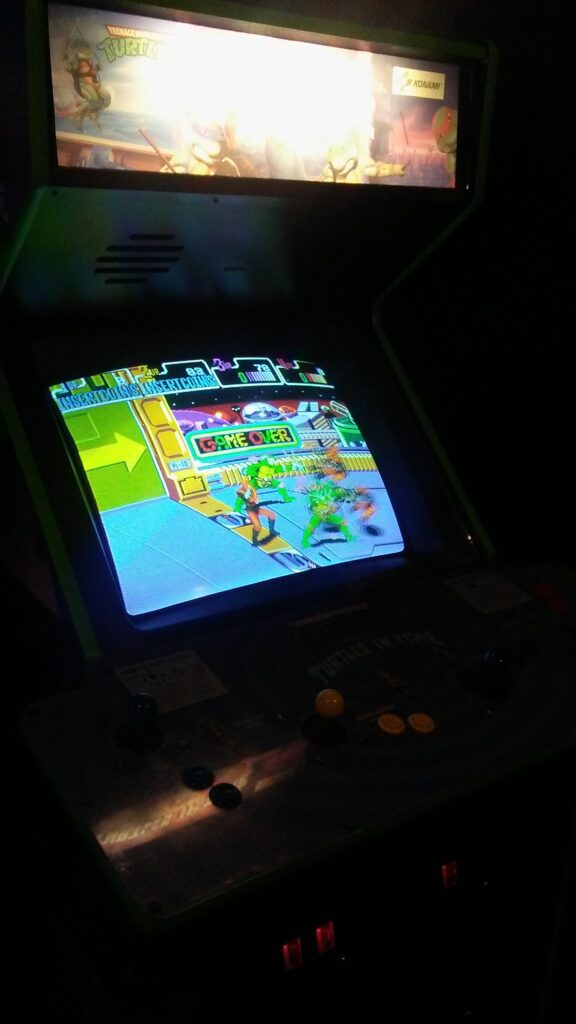

Teenage Mutant Ninja Turtles and Turtles in Time: Speaking of Konami beat’em ups, it’s not one but BOTH Ninja Turtles arcade games. When I was a toddler, most arcade games were too high for me to reach without a stool of some sort properly. Thankfully, Circus Circus had my back, with a variety of small child-sized cabs of the most popular games of the time, allowing my 5-year-old Ninja Turtles-loving self to die on the first level over and over.

Jurassic Park The Lost World: While the full-sized machine would be too big, every arcade must have a Jurassic Park. You can see the pizza counter to the left, but I wasn’t hungry enough to bother with their four dollar a slice pizza.

Revolution X: If you’ve never seen this game before, take a guess what it’s about. Go ahead.
…
If you said, “shooting up bad guys in a dystopian city while rescuing Aerosmith,” you’re correct!
This game is so over-the-top it feels more like a parody of 90s arcade games than something that was really made. Every enemy you kill explodes into graphic gibs and/or red jello. Every single piece of scenery you destroy drops CDs to collect points. Early on in the game, you find yourself shooting your way through a strip club, freeing the strippers from gogo dancer cages, and freeing them results in them popping up at the bottom of the screen blowing you a kiss with the most over-the-top “sexy” voice clips possible (and you can walk in on a member of Aerosmith making out with one behind a curtain). All this while Aerosmith’s greatest hits play on a loop in the background.
To think, THIS was almost the Jurassic Park arcade game until some licensing issues forced them to retool it.

Pac-man VS: This building has over 30+ retro arcade machines. And one modern one. Words don’t begin to describe how out of place this thing looks. I guess they decided anything Pac-man-related was retro by default. Do you know that giant four-player Pac-man game they have at every Dave and Buster’s? This is that game, except about a fifth of the size.

Out-Run: This probably looks generic by today’s standards, but it’s one of the most influential games of the arcade racing genre. Unlike most racers at the time, this game puts you in the driver’s seat of a red convertible while you cruise through a race track with multiple paths and endings. As you progress, the scenery transitions to mountains, deserts, and forests. In this one, you can feel the DNA of later series like Cruisin’ USA.

Frogger, Paperboy, Ikari Warriors: While I’ve already said everything I can about those first two (which wasn’t much in the first place), Ikari Warriors is just a game I’m not all that versed in. I’ve heard the name, so I’m sure it has some legacy behind it, but you’d have to ask someone else. I can tell you that Ikari Warriors is a game they have here, though. Sorry SNK.
Blasteroids: This one I happen to know a bit about, though. As the name suggests, this is the sequel to Asteroids (one of them, at least). You probably imagine Asteroids with better graphics and a few new enemies from that alone. While that’s not exactly “wrong,” there’s a LOT more to this game than you’d expect. For starters, your ship now has a “transform” button that switches you between three ship configurations with different stats (fast and strong, slow and weak, and regular). On top of that, this game has a stage select screen between levels where you can decide which square of the map you want to move to next, each having different enemy spreads. The biggest game changer is that you now have a health bar tied to your boost button, forcing you to constantly collect fuel and other powerups from broken Blasteroids and enemies to stop dying. They did a LOT with a game about making a spaceship spin around shooting rocks.
For whatever reason, it was never included in those Midway arcade game collections that they made so damn many of, so it hasn’t seen the light of day since the original 1987 release. That is, until last year, a playable version was included in the Midway Games world of Lego Dimensions. What a weird place for this game to get its first re-release in two decades…

Maximum Force: Don’t you dare try to tell me you haven’t seen this game before. This game, and its predecessor Area 51, were the late 90s equivalent of the Fast and the Furious. Every arcade, pizza place, and theater had these games. When people think of generic rail shooters, this is probably the one the comes to mind.
House of the Dead 1 and 3: I accidentally deleted the picture while I was getting them off my phone, but both of them were right between this and Revolution X.

Mortal Kombat 1 and 4: Oh hey, I think this means Minneapolis has all four Mortal Kombat games! The first four, anyway. Maybe I should learn a fighting game someday. I’ve made a few half-assed attempts with King of the Fighters, but the entry-level on these games is so damn high. It’s awful if you don’t have human players to practice against.
Killer Instinct 2: Street Fighter and Mortal Kombat were quite an interesting pair back in the day because each game shaped the fighting genre on each side of the ocean. While Japan got a flood of anime-Esque Street Fighter clones, America and the UK got a lot of games following Mortal Kombat’s footsteps with prerendered graphics and gore. Killer Instinct was probably the most prominent of those. The only thing I know about it is that it had Saburwolf.

Primal Rage: Remember those Mortal Kombat-Esque games I talked about two sentences ago? This is another one of them. Primal Rage set itself apart from the crowd with some gimmicks. First, instead of human beings, the game revolves around making dinosaur (and a few ape) gods duke it out for control of the planet. It’s every bit as radical as it sounds. The game’s second noteworthy point is that all its characters were done in stop-motion instead of prerendered CGI or mo-cap actors, giving it a unique look. The third, perhaps most remembered thing about this game is that it turns the gore up to 11. For example, each player’s life bar is a giant red artery connected to a realistic heart in the corner of the screen. When you die, your heart explodes into a huge bloodstain. On top of that, every time you hit your opponent, you not only get to see blood spray out of them, but you get to cover the floor in giant blood puddles. Whoever was behind this game knew damn well what Mortal Kombat’s main draw was.
Oh yeah. And there’s a monkey who can piss on people.
Out of Order Marvel vs. Capcom: I know of a laundry mat that has a copy of this game that isn’t broken. Because I check every local laundry mat for arcade games. We all need hobbies.

Street Fighter II Champion Edition: Thankfully, this is the last fighting game because I never know what to say about them. I mean, hell, what do you say about Street Fighter II that hasn’t already been said? It’s Street Fighter II!
I could skip the unimportant machines like I usually do, but nothing in this bar was really “unimportant” enough that I could justify ultimately omitting it. It’s their fault for having such good taste in games.

Tron: Look at this machine. This is possibly the most 80s-looking arcade machine ever produced. This machine is beautiful, and I’m glad the shitty phone camera managed to do it justice. That blue transparent controller. That pink light bar. Those orange decals are meant to look like screens. I could stare at this all day.
The game is interesting because it almost reminds me of a very primitive Wario Ware or Bishi-Bashi with only four minigames. You choose from one of four minigames, get a quick screen giving a sentence of instructions explaining the objective with a diagram of how to use the controller; then you’re dropped into a game that can be cleared in 20 seconds, then repeat the process. The difficulty of the games increases each time you get through all four. It’s a good game for what it is.

Dig-Dug and Galaga: I’ve been writing this blog post for three days. Leave me alone. You people already know what these games are.

Moon Patrol: This is the first video game ever to use parallax scrolling (that thing where parts of the background scroll at different speeds, giving it a sense of depth). Unlike Blastroids, this game gets included in Midway compilations sometimes.
Tapper: Alright, a working Tapper machine! This is one of the two games I played more than any other. The gameplay is simple: Customers start on one side and slowly slide over to you. You must slide them beer to push them back. If you push them back far enough, they disappear. If you don’t push them back, they’ll return their empty mug to you, which you need to catch before it falls off the counter. The catch is that you need to clear all the customers on the screen to win, but new ones will spawn every few seconds. You need to clear them really, really soon after the stage starters, or else you’ll find yourself fighting so many customers that you can’t remove them before more spawn (and having to keep track of the empty mugs doesn’t help).

Crystal Castles: This seems like the kind of game I’d go “blah blah” and skip over, doesn’t it? Well, I’ve got a LOT to say about this game. For starters, let’s talk about the game itself. It plays like a 3-d isometric Pac-man, where you must collect gems while enemies chase you down. What makes it different from Pac-man becomes immediately apparent as soon as you play for the first time. You move fast compared to Pac-man because of the trackball controls. The enemies are dumb as rocks, so a big part of the game involves tricking them into chasing you to some part of the map where there aren’t any crystals, then sprinting over to where they’re not. Like you can see in the picture, each enemy has their own gimmicky way of dealing with them if you want to dispose of them permanently. This game is notable because you can beat it, which was an extremely rare feature in arcade games of the time. If you clear all 30-something levels, you get to see the ending. On top of that, there’s a cool feature where the first level has a big, empty “mountain” that’s been terraformed to spell out the player’s initials with the high score. It’s the little things. Hell, Atari had so much faith in this game that they were trying to push Bently Bear as their mascot (Pac-man is Namco’s mascot, not Atari’s). For a good reason, since this game is excellent.
This leads to a personal anecdote. When I was a kid, my first gaming console was an Atari 2600, inherited from my dad when I was five or six. He had two large bins of games for the thing. By the time I was old enough to play it, it was probably ’92 or ’93, and you obviously couldn’t find games for the item at ToysRus anymore. I’d often find them at yard sales, though. One day, while we were shopping at Big Lots, they had a giant rack of new Atari games they had found somewhere. I already had nearly every game there, but one of them stood out as “new.” Crystal Castles. It ended up being the one and only Atari game I ever got new (the game came out in ’83, so it was an ancient game by that point). It’s my favorite 2600 game of all time, not just for sentimental reasons. It’s good for an Atari game. The game even looks excellent compared to nearly everything else on the system. You can tell what everything’s supposed to be!
Enough sharing. I want to get this blog post over with. It’s probably the length of a small essay by now.

Burger Time and Tetris: I wanted to play Burger Time, but people were always hogging it. Speaking of which, there was a guy on that Ms. Pac-man machine for like an hour playing it non-stop. All these games, and that’s the one you spend your tokens on?

EDIT: There was originally a rant about Killer Queen here. Six years later, when cleaning up the blog for its new host, I’ve opted to remove it. It was a bit too much, even for me. I’ll be sure to talk about the game next time I run into an arcade that has it.
…is that it? Am I done? Five thousand two hundred sixty-eight words talking about one arcade. Usually, when I write about arcades, I like to write about other stuff in the area, too, because most arcades don’t have enough substance for a stand-alone article. Man, am I glad it was too cold for that this time. Remember, I do this for archival. If someday this arcade isn’t there anymore, this tribute will still exist, detailing every bloody corner of the place.
Except for the two House of the Dead machines.

